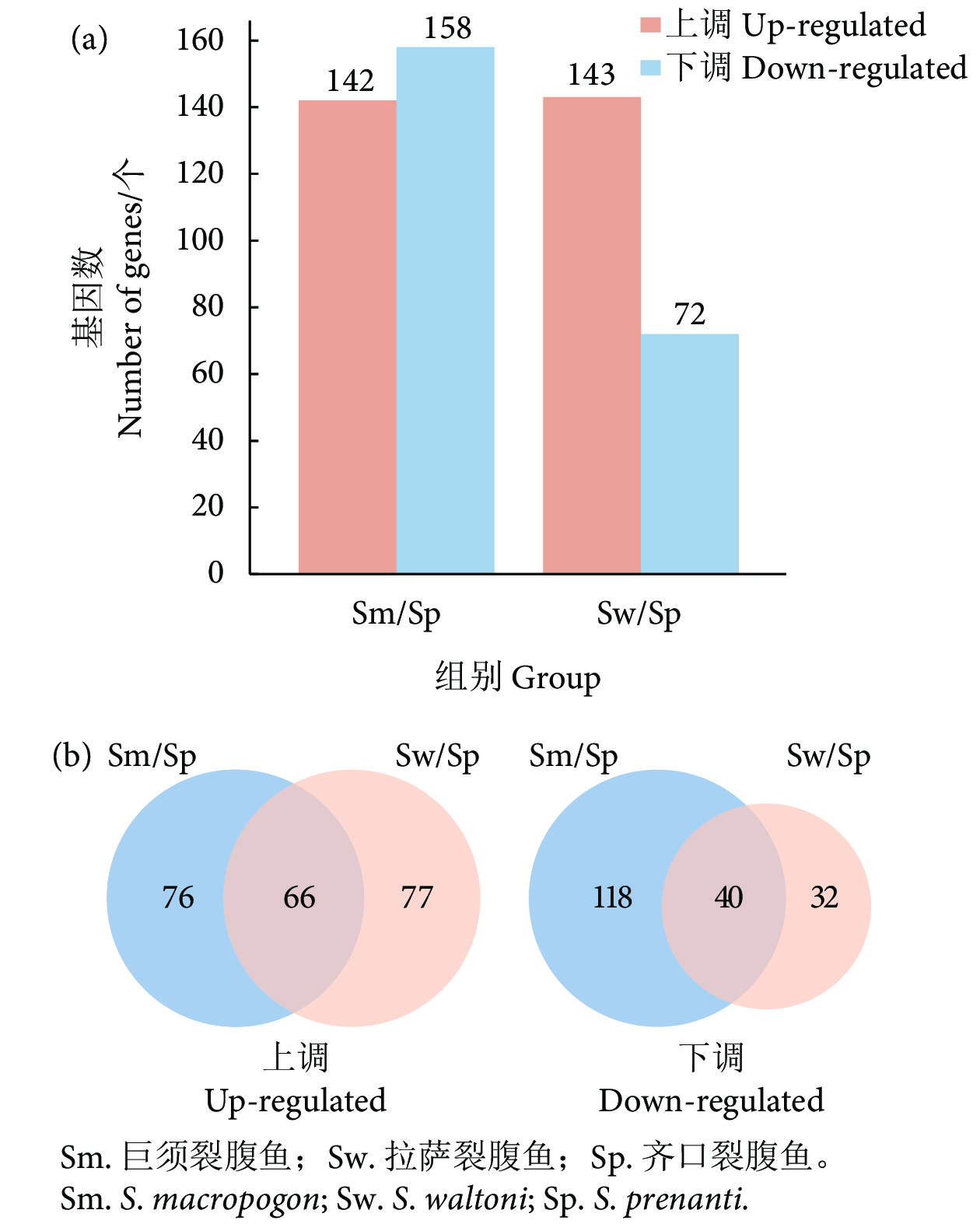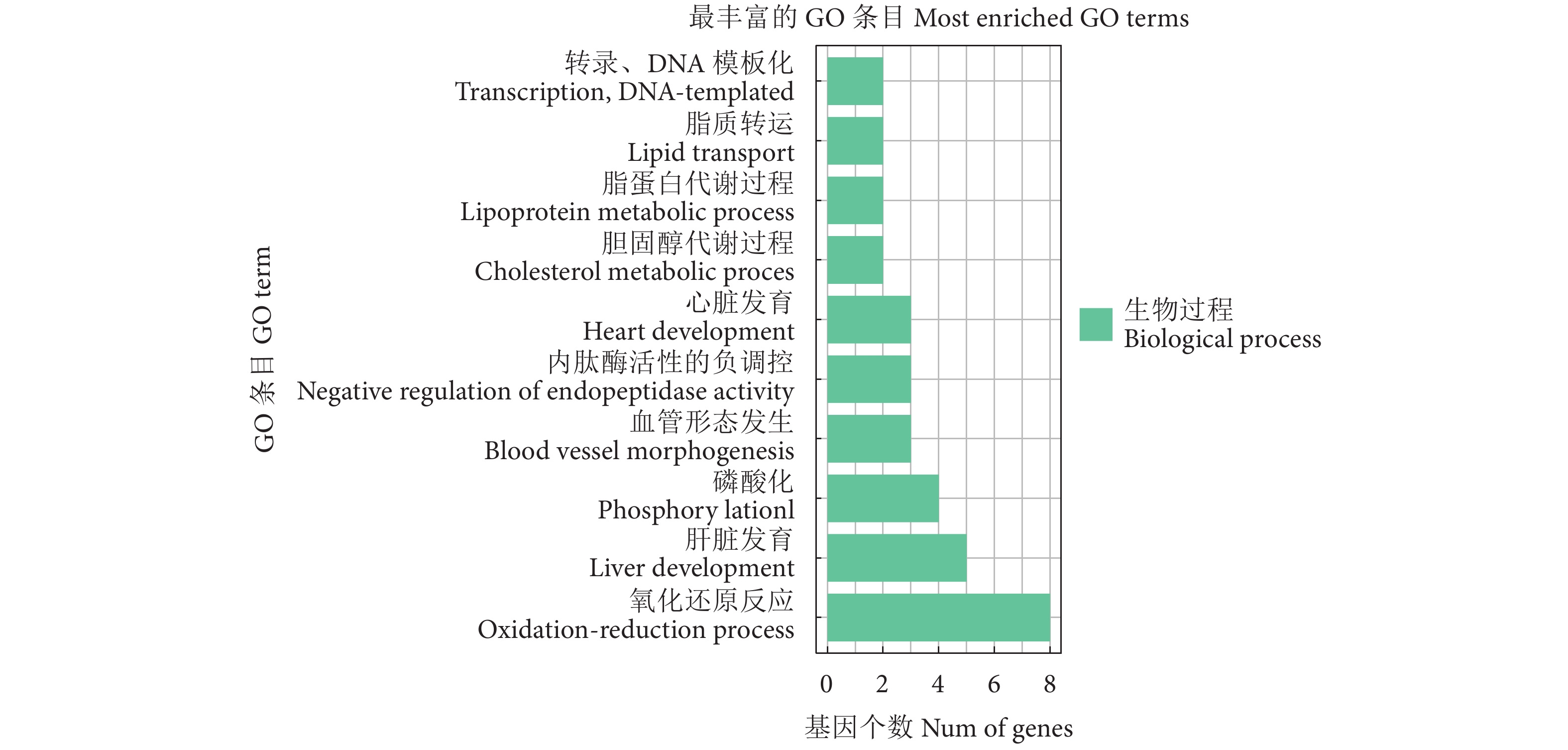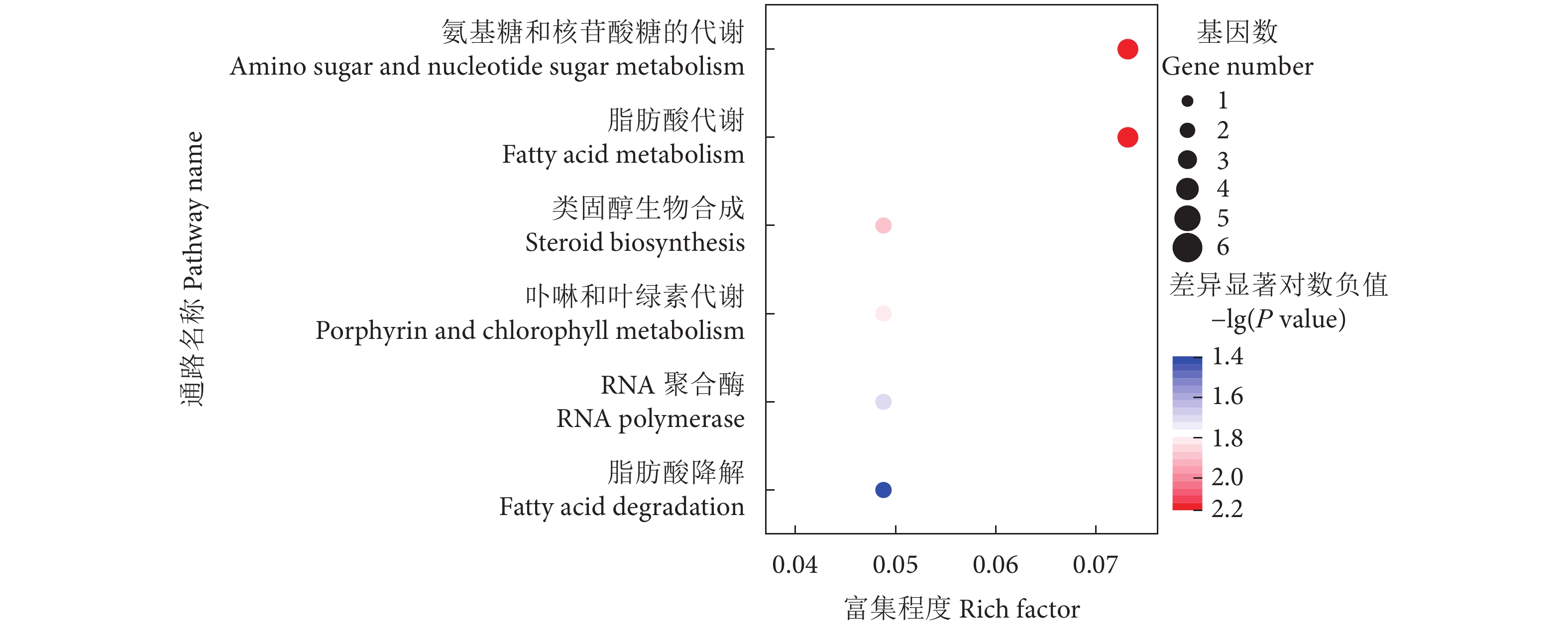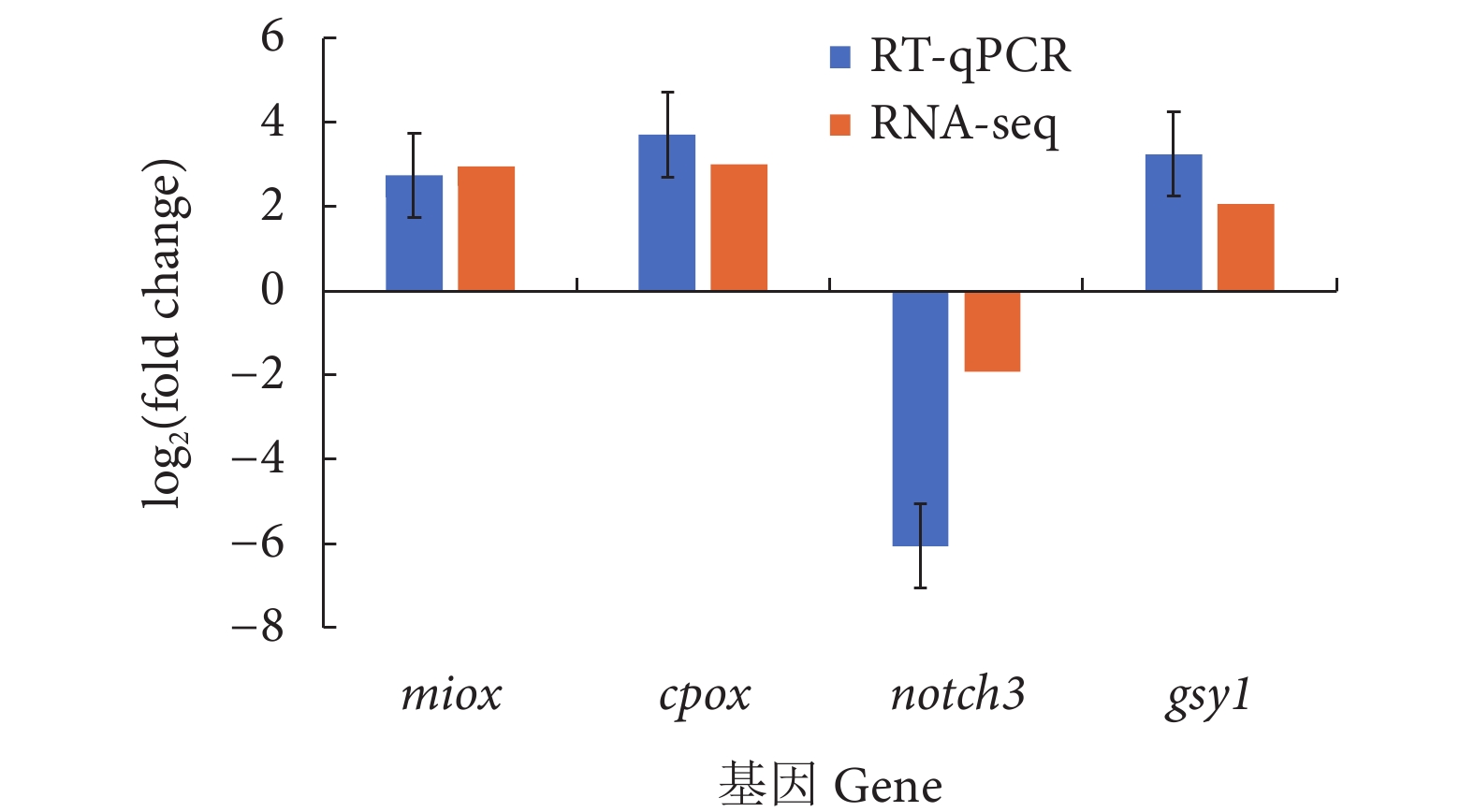Transcriptome comparative analysis of liver tissues of three plateau Schizothoracinae fish species
-
摘要:
青藏高原低温、低氧的极端环境特征是生物适应性进化的天然实验室。裂腹鱼亚科鱼类广泛分布于青藏高原附近水域,在长期进化过程中适应了独特的高原环境。为揭示裂腹鱼适应高原环境的关键信号通路,以2种高海拔 (>3 000 m) 的高原裂腹鱼 [巨须裂腹鱼(Schizothorax macropogon)、拉萨裂腹鱼(S. waltoni)] 和1种低海拔 (<1 000 m) 的原始裂腹鱼 [齐口裂腹鱼(S. prenanti)] 为研究对象,对3种裂腹鱼的能量代谢主要组织—肝脏进行转录组测序比较分析。通过对高海拔与低海拔裂腹鱼肝脏转录组的比较,在2种高海拔裂腹鱼中找到共同差异变化的基因106个,其中66个基因表达上调,40个下调。GO和KEGG富集分析显示,氧化还原过程、血液发生相关途径、氨基酸的代谢和类固醇的生物合成是高海拔裂腹鱼应对高原环境的最重要途径。其中,氧化还原和血液生成相关基因 (如:faxdc2、cpox、cyp51和NADH-cytochrome b5 reductase 2) 的高表达可能在应对高原环境中发挥着重要作用。该研究为鱼类高原低氧适应的分子机制研究提供了新见解。
Abstract:The extreme environmental features of low temperature and low oxygen on the Qinghai-Tibet Plateau provide a natural laboratory for the evolution of biological adaptability. The subfamily Schizothoracinae are widely distributed in the water bodies surrounding the Qinghai-Tibet Plateau, and has adapted to the unique highland environment through long-term evolutionary process. In this study, we focused on two high-altitude (>3 000 m) Schizothoracinae fish species (Schizothorax macropogon and S. waltoni) and one low-altitude (<1 000 m) ancestral Schizothoracinae fish species (S. prenanti) to conduct a transcriptome sequencing comparative analysis regarding the liver tissues, which is the main energy metabolism organ in fish species. This analysis reveals the key signaling pathways involved in the adaptation of highland Schizothoracinae to high-altitude environment. Comparing the liver transcriptomes of high-altitude with those of low-altitude Schizothoracinae, we identified 106 genes that shared differential changes in expression between the two high-altitude species. Among these genes, 66 were upregulated and 40 were downregulated. GO and KEGG enrichment analysis reveals that the most important pathways for high-altitude adaptation in Schizothoracinae include oxidation-reduction processes, pathways related to blood development, amino acid metabolism and steroid biosynthesis. Among them, genes related to oxidation-reduction and blood development (faxdc2, cpox, cyp51, and NADH-cytochrome b5 reductase 2) with high expression levels might play a crucial role in high-altitude adaptation. The study provides new insights into the molecular mechanisms underlying the adaptation of fish to high-altitude environment.
-
Keywords:
- Schizothoracinae /
- Liver /
- Transcriptome analysis /
- Plateau /
- Hypoxia
-
青藏高原作为世界海拔最高的地理区域,山脉平均海拔高度在4 000 m以上,是印度和亚欧大陆两大板块剧烈碰撞的结果[1-2]。青藏高原不同水域的溶解氧变动大,浮动范围介于4.0~7.4 mg·L−1[3]。独特的低氧极端环境特征使其成为了生物适应性进化的天然实验室,而适应青藏高原环境的生物在长期进化过程中形成了独特的进化机制。
裂腹鱼亚科鱼类是一种生活在中国高海拔水域的特殊鱼类,主要栖息在青藏高原海拔400~5 000 m的河流或湖泊中,包括15属,约100种。其对不同的高原环境表现出特殊的适应性[4]。巨须裂腹鱼 (Schizothorax macropogon)、拉萨裂腹鱼 (S. waltoni) 和齐口裂腹鱼 (S. prenanti) 同属鲤科、裂腹鱼亚科、裂腹鱼属。前两者主要分布于海拔高于3 000 m的雅鲁藏布江及其附属水体中,是青藏高原特有的经济鱼种和土著鱼种[5],属于高度特化类群;后者则是一种平原冷水底栖鱼类,通常分布于海拔低于1 000 m的水域,是一种重要的经济养殖鱼类[6]。
肝脏是鱼类参与体内物质代谢的关键器官,也是机体进行糖脂代谢、维持营养平衡的主要器官,可分泌肝因子,经旁分泌或内分泌途径,调控其他组织代谢,进而影响全身能量代谢[7]。已有研究发现,肝脏参与的能量代谢在环境胁迫应对中发挥着重要作用。如王维政等[8]对低氧胁迫下军曹鱼(Rachycentron canadum) 的肝脏能量代谢研究发现,其在低氧环境下会发生厌氧糖酵解,通过肝糖原分解为机体提供大量能量,并调整代谢途径。Ma等[9]研究发现,低温胁迫会影响罗非鱼肝脏的脂肪酸去饱和化,并增强膜流动性。
转录组测序技术作为一种生物学研究方法,由于具有高通量、高准确性、高效性,近年来在鱼类适应性研究中应用广泛。研究物种除了模式生物斑马鱼 (Danio rerio)[10]外,还包括众多水产养殖物种,如斑点叉尾鮰 (Ictalurus punctatus)[11]、鳜 (Siniperca chuatsi)[12]及大黄鱼 (Larimichthys crocea)[13-14]等。关于裂腹鱼属,Barat等[15]利用深度RNA测序破译了理氏裂腹鱼 (S. richardsonii) 的转录组,研究其肝脏中与热休克反应有关的基因和分子途径。Chen等[16]使用比较转录组分析总溶解气体 (Total dissolved gas, TDG) 胁迫对重口裂腹鱼 (S. davidi) 的影响,发现TDG 过饱和会引起天冬氨酸氨基转移酶 (AST)、丙氨酸氨基转移酶 (ALT) 和超氧化物歧化酶 (SOD) 活性改变。孔庆辉等[17]通过高通量测序平台研究水霉菌感染的巨须裂腹鱼脾脏组织来理解感染机制。
肝脏作为鱼类能量代谢与供应的主要器官,对探究高原裂腹鱼体内能量变化和适应低氧环境有着重要作用。然而,不同海拔裂腹鱼肝脏组织的转录组比较研究尚未见系统报道。为探究高原裂腹鱼肝脏组织在应对极端低氧高原环境中的作用,本研究针对2种高海拔特化的高原裂腹鱼 (>3 000 m的巨须裂腹鱼和拉萨裂腹鱼) 和1种低海拔的原始裂腹鱼 (<1 000 m的齐口裂腹鱼) 开展肝脏转录组比较研究,揭示肝脏组织在高原低氧适应中的特殊信号通路与机制。
1. 材料与方法
1.1 裂腹鱼样品采集处理
采集3种不同海拔的青藏高原裂腹鱼。根据其栖息地位置,共在2个地点采集裂腹鱼样本。高原裂腹鱼是高原地区的重要鱼类种群,可承受极端环境,其肝脏有着特殊的调节机制。因此,于2019年在西藏自治区拉萨附近湖泊 (91°E, 29°41'N) 海拔3 650 m采集巨须裂腹鱼和拉萨裂腹鱼作为高海拔组样本;在四川省眉山附近湖泊 (103°47'E, 30°04'N) 海拔650 m处采集齐口裂腹鱼,作为低海拔对照组样本。选取体长、体质量基本一致的裂腹鱼麻醉致死后进行解剖,分离肝脏组织,每种鱼解剖3尾作为重复样本,共计9个肝脏样本。将样本做好标记后于 −80 ℃保存备用。
1.2 总RNA提取及文库构建与测序
针对3种裂腹鱼的9个肝脏组织样本,使用 Trizol RNA抽提试剂盒 (Invitrogen,Carlsbad,美国) 制备9个样本的总RNA。利用凝胶琼脂糖电泳和分光光度计评估RNA的浓度和纯度 (OD260 nm/OD280 nm介于1.8~2.1)。使用VAHTS Universal V6 RNA-seq文库制备试剂盒构建cDNA文库。随后,利用Illumina hiseqtm 2000测序仪 (San Diego,美国) 进行裂腹鱼各样本的转录组双端测序。
1.3 转录组数据处理
双端测序分析的读长为150 bp,首先得到 fastQ文件测序结果。通过Trimmomatic 0.33软件[18]进行数据处理,去掉接头序列、低质量的reads数据。具体参数为:AVGQUAL为20、TRAILING为20、MINEN为50。数据质量评估后,使用Hisat2 v2.0.4软件将clean reads与参考基因组进行比对。基于各裂腹鱼样品的最终比对结果,使用Trapnell等[19]对基因转录本表达量水平进行评估定量和标准化处理。
1.4 差异表达基因分析
在Cuffliks软件默认设置下,计算每个样本的基因表达水平,以确定每个基因每千个碱基转录物中每百万个映射片段的reads (Fragments perkilobase of exon model per million, FPKM)。计算表达量的FPKM值,用以抵消测序量差异影响。根据计算出的表达量结果,使用 EdgeR 程序包[20]根据基因表达量进行下一步操作,对不同分组的裂腹鱼进行差异表达分析。
巨须裂腹鱼 (S. macropogon, Sm) 和拉萨裂腹鱼 (S. waltoni, Sw) 均采自3 650 m的高海拔水体作为高海拔组,分别与低海拔的齐口裂腹鱼 (S. prenanti, Sp) 进行比较,分别记为Sm/Sp和Sw/Sp。由此得到2组不同海拔高度裂腹鱼的差异表达基因 (Differentially expressed gene, DEG)。在差异基因表达分析中,以 |log2(foldchange)|>1及 P<0.05作为差异基因筛选标准。
1.5 差异表达基因富集分析
针对裂腹鱼各分组的差异表达基因,进行GO和KEGG富集分析。选择P<0.05的GO项或KEGG通路作为显著富集。采用R语言中的ggplots2 (3.3.2)软件包绘制GO及KEGG图。
1.6 实时荧光定量PCR验证
为了验证转录组分析的准确性,随机挑选出 4个差异表达的基因 (表1),使用PrimeScriptTM II 1st Strand cDNA Synthesis Kit试剂盒将样本中的RNA反转录为cDNA。根据基因序列设计实时荧光定量引物,使用ChamQ Universal SYBR qPCR Master Mix试剂盒 (Qiagen) 在荧光定量PCR仪上进行 RT-qPCR 检测。采用 2−ΔΔCt方法对目的基因的表达水平进行分析。使用 SPSS 18.0 软件进行统计分析,实验结果经单因素方差分析 (One-way ANOVA),若存在显著性差异,再采用 Duncan's法进行多重比较 (P<0.05)。
表 1 引物序列及信息Table 1 Primer sequences and information基因
Gene上游引物
Forward sequence下游引物
Reverse sequence产物长度
Product length/bpGAPDH GTTCCCACCTACGAGACGC ATCCAGAATGGCAACAACTACA 121 miox CGGAGACTACATGCACTTAT TAATACGGCCTCAGACTCTC 128 cpox GGAAGCTGCCGTTCTGTGCC TTCCTCCACCAAACCACCAC 140 gys1 ATGAACAGCAGTGGGTGCAA CGAACCAGGGCACACCAATA 153 notch3 GAATGCCGCTGCGCTGAA CAAGTGTAACTGGCAATGCC 115 2. 结果
2.1 两种海拔裂腹鱼肝脏组织的基因表达差异
对两种不同海拔高度的3种高原裂腹鱼肝脏进行转录组测序。以 |log2(foldchange)|>1及 P<0.05作为标准进行差异基因DEGs筛选,并使用EdgeR对3种裂腹鱼肝脏组织进行差异表达分析。
在巨须裂腹鱼和齐口裂腹鱼 (Sm/Sp) 的比较中,共找到了300个显著差异表达基因,包括142个上调基因和158个下调基因;在拉萨裂腹鱼和齐口裂腹鱼 (Sw/Sp) 的比较中,共有215个显著差异表达基因,包括143个上调基因和72个下调基因 (图1-a)。在Sm/Sp和Sw/Sp 2组比较中,同时表达上调的基因有66个,同时表达下调的基因有40个 (图1-b)。选取2组比较中有共同差异的106个基因进行后续的富集分析。
2.2 2组裂腹鱼比较共同差异表达基因GO功能 富集
对共有的106个差异表达基因进行GO显著富集分析,筛选P<0.05的GO 条目。结果发现,共有95条显著富集的GO条目;其中,51条注释到生物过程 (Biological process, BP),9条注释到细胞组分 (Cellular component, CC),35条注释到分子功能 (Molecular function, MF)。
在生物过程类型中,按GO条目中基因数量选取前10条,其中包含基因最多的条目是氧化还原过程 (GO: 0055114),其次是肝脏发育 (GO: 0001889),也是显著富集程度最高、P最小的GO条目 (图2)。与血液发生相关的一些通路:血管形态发生 (GO: 0048514)、心脏发育 (GO: 0007507)、心肌收缩的调节 (GO: 0055117)、凝血负调控 (GO: 0030195)、心率调节 (GO: 0002027) 等GO条目也显著富集 (图2)。与脂代谢相关的通路:脂质运输 (GO: 0006869)、脂蛋白代谢过程 (GO: 0042157)、胆固醇代谢过程 (GO: 0008203) 也被显著富集 (图2)。可见,这些通路在高海拔裂腹鱼极端环境适应中具有重要作用。
在氧化还原过程中,NADH-cytochrome b5 reductase 2、 pdia6、cyp51、miox、cpox、 faxdc2 这6个基因在Sm/Sp和Sw/Sp组中均表达上调,其中NADH-cytochrome b5 reductase 2基因差异倍数最大,faxdc2基因差异倍数最小;与血液发生相关的hhex、alpha-2-macroglobulin-like、calm2.L、gys1这4个基因在Sm/Sp和Sw/Sp组中均表达上调,其中hhex基因差异倍数最大,gys1基因差异倍数最小 (表2)。总体看来,氧化还原过程中,高海拔裂腹鱼肝脏中上调的基因占比较多 (表2)。
表 2 GO富集的差异表达基因Table 2 Deferentially expressed genes enriched by GO enrichment analysisGO 通路
GO pathway基因
Genelog2FC P 调控
RegulationSm/Sp Sw/Sp Sm/Sp Sw/Sp 氧化还原过程
Oxidation reduction processNADH-cytochrome b5 reductase 2 6.360 6.543 5.04×10−5 0.001 5 上调 pdia6 5.201 8.303 0.007 5 7.91×10−5 上调 cyp51 3.428 4.258 0.000 7 0.000 6 上调 miox 2.676 2.951 1.97×10−5 0.006 4 上调 cpox 2.329 3.014 0.001 4 0.006 3 上调 faxdc2 1.524 2.609 0.049 0 0.016 4 上调 cyp27a2 −2.708 −3.293 5.26×10−5 0.001 6 下调 prdx5 −6.616 −2.786 1.51×10−13 0.010 5 下调 血管形态发生
Blood vessel morphogenesishhex 5.991 5.648 9.35×10−11 3.90×10−5 上调 alpha-2-macroglobulin-like 3.741 3.161 8.48×10−8 0.003 5 上调 calm2.L 3.454 3.461 0.002 3 0.024 1 上调 gys1 4.241 2.059 3.80×10−9 0.040 5 上调 stk25a −2.708 −5.887 0.022 8 0.005 1 下调 notch3 −1.407 −1.926 0.033 9 0.041 6 下调 f7i −2.528 −2.218 0.004 8 0.032 1 下调 sh3gl3b −3.354 −4.912 0.027 4 0.009 9 下调 注:Sm. 巨须裂腹鱼;Sw. 拉萨裂腹鱼;Sp. 齐口裂腹鱼。 Note: Sm. S. macropogon; Sw. S. waltoni; Sp. S. prenanti. 2.3 2组裂腹鱼比较共同差异表达基因KEGG功能富集
在对Sm/Sp和Sw/Sp组比较共有的差异表达基因的KEGG富集分析中发现,差异基因共富集到60条通路上,其中显著富集通路及P<0.05的有6条:氨基糖和核苷酸糖代谢、脂肪酸降解、脂肪酸代谢、类固醇生物合成、卟啉与叶绿素代谢、RNA聚合酶 (图3)。
氨基糖和核苷酸糖代谢、脂肪酸代谢显著富集程度最高,这两个通路均包含 3个基因,其余有关脂肪代谢的通路,包括类固醇生物合成和脂肪酸降解也有被富集。富集途径主要涉及糖脂代谢、转录和血液发生等通路,与GO富集分析结果基本相同。
氨基糖和核苷酸糖代谢中的基因包括uap1、nansa、NADH-cytochrome b5 reductase 2,类固醇生物合成包含的基因为faxdc2、cyp51,卟啉与叶绿素代谢包含的基因为hmbsa、cpox,且这7个基因在Sm/Sp和Sw/Sp组中均表现为上调。值得一提的是,富集的这3条通路涉及到的7个基因在高海拔裂腹鱼肝脏中的表达均显著上调 (表3)。
表 3 KEGG富集的差异基因Table 3 Deferentially expressed genes enriched by KEGG enrichment analysisKEGG 通路
KEGG pathway基因
Genelog2FC P 调节
RegulationSm/Sp Sw/Sp Sm/Sp Sw/Sp 氨基酸糖和核苷酸糖代谢
Amino sugar and nucleotide sugar metabolismuap1 3.458 3.054 0.000 7 0.011 1 上调 nansa 4.661 5.615 0.013 2 0.007 3 上调 NADH-cytochrome b5 reductase 2 6.360 6.543 5.04×10−5 0.001 5 上调 类固醇的生物合成
Steroid biosynthesisfaxdc2 1.524 2.609 0.049 0 0.016 4 上调 cyp51 3.428 4.258 0.000 7 0.000 6 上调 卟啉和叶绿素代谢
Porphyrin and chlorophyll metabolismhmbsa 4.730 4.646 0.000 2 0.004 5 上调 cpox 2.329 3.014 0.001 4 0.006 3 上调 结合GO和KEGG富集分析结果可以看出,不同海拔高度对裂腹鱼肝脏的影响主要集中于氧化还原、糖脂代谢和血液发生 (图2、图3)。而这些通路中涉及的基因在高海拔裂腹鱼肝脏中的表达大部分为上调;表明这些通路被激活表达,在低氧适应中发挥重要作用 (表2、表3)。
2.4 富集分析通路重要基因热图分析
基于样本鱼重要通路中的差异基因表达量,绘制各通路热图 (图4)。有关血液发生中的重要基因可知hhex和gsy1基因在巨须裂腹鱼中的相对表达量更高 (图4-a)。图4-b和图4-c分别为氧化还原重要差异基因和KEGG通路里的重要差异基因,这2个通路共有基因为 faxdc2、cpox、cyp51和NADH-cytochrome b5 reductase 2,说明这些基因对高原裂腹鱼应对低氧有重要作用。
2.5 转录组数据的RT-qPCR验证
根据转录组分析结果,随机挑选4个差异表达基因,利用实时荧光定量PCR检测基因表达情况。如图5所示,4个差异基因的检测结果和转录组分析结果一致,证实了转录组分析的真实性。
3. 讨论
3.1 高原鱼类的转录组分析研究
氧是维持几乎所有生物正常生存所必需的环境因子。溶解氧是水产养殖中的重要环境因子之一,直接关系到鱼类的生存、生长和代谢水平[21]。与陆生生物相比,水生生物更容易受到缺氧条件的影响。缺氧是对鱼类生存的一种挑战,会导致生物体能量供应不足和氧化损伤,严重时会导致鱼类死亡[22]。在高原地区,氧气 (O2) 压力低、含量相对较少,这对于大部分生物都是一个挑战。然而,高原鱼类通过长期进化,形成了一系列受高原环境正选择的基因以应对高原低氧环境。
青藏高原鱼类主要分为高原鳅属 (Triplophysa) 鱼类、鰋鮡鱼类和裂腹鱼类3个类群。Wang等[22]利用转录组分析发现,达里湖高原鳅 (T. dalaica)与鲢 (Hypophthalmichthys molitrix) 和泥鳅 (Misgurnus anguillicaudatus) 相比,hif-1αB和hif-2αA基因经历了正选择。Ma等[23] 比较了生活在海拔100~4 000 m的6种鲶的肝脏转录组,发现其与生活在平原地区的中华鲶 (Silurus asotus) 相比,与缺氧和能量代谢相关的大量基因快速进化。Yang等[24]通过转录组测序发现,厚唇裸重唇鱼 (Gymnodiptychus pachycheilus) 中与缺氧和能量代谢功能类别相关的许多基因均快速进化。Yu等[25]对分布超过海拔4 000 m 的高软刺裸鲤 (G. dobula) 和怒江裂腹鱼 (S. nukiangensis) 的转录组测序及进化分析后发现,许多与能量代谢相关的基因在高海拔裂腹鱼中出现了正选择特征,但这2种鱼中很少有正选择基因重叠,推断青藏高原鱼类对高原的遗传适应存在差异。
从众多对高原鱼类的转录组分析中可见,能量代谢相关途径在高原鱼类低氧应答中发挥着重要作用。因此,本研究以2种高海拔的高原裂腹鱼和1种低海拔的原始裂腹鱼为研究对象,对3种裂腹鱼的能量代谢主要组织肝脏进行转录组测序比较分析,以进一步揭示高原裂腹鱼适应高原环境的关键信号通路。3种裂腹鱼虽均同属裂腹鱼属,但高海拔与低海拔裂腹鱼 (Sm/Sp和Sw/Sp组) 的比较均属于跨物种比较。为减少跨物种比较中种间差异的影响,本研究选取了2组中的共同差异表达基因 (106个) 开展富集分析。上述共同差异基因主要富集到能量代谢、氧化还原过程及血液发生相关途径。
3.2 能量与生物合成在低氧适应中的作用
肝脏作为新陈代谢、能量储备、生物合成的主要器官,在鱼类适应低氧环境中发挥着重要作用[26]。为了应对低氧环境,鱼类通常会通过改变代谢途径获取能量或者降低代谢率[27]。有研究表明,急性低氧条件下,大黄鱼肝脏中与能量代谢相关的基因表达发生变化,在低氧条件下会调整能量代谢途径[28]。本研究对2种高海拔和1种低海拔裂腹鱼肝脏转录组比较获得的差异基因的GO富集显示,与脂代谢相关的通路 (脂质运输、脂蛋白代谢过程、胆固醇代谢过程) 在高海拔的裂腹鱼中显著富集。KEGG富集分析显示,氨基糖和核苷酸糖代谢、类固醇生物合成以及卟啉与叶绿素代谢中的6个基因均上调。faxdc2基因的过表达会促进GM3合成酶的增加,从而促进脂肪代谢[29],cyp51是生物合成甾醇过程中的一个关键酶,在脂质代谢中起到重要作用[30]。由此可见长期适应高原环境的裂腹鱼,可能通过提高脂质代谢途径来应对低氧环境。Yang等[31]通过研究东北尖头鱥 (Phoxinus lagowskii) 在缺氧条件下的代谢变化,发现其脂质代谢活性酶增加,表明脂质代谢在增强其低氧适应过程中起到重要作用。Sun等[32]通过研究大口黑鲈 (Micropterus salmoides) 在急性缺氧下的葡萄糖和脂质代谢变化,发现在缺氧条件下大口黑鲈肝脏中脂肪酸的活化会增强。因此,提高脂质代谢是高原生物适应低氧环境的重要机制之一。
3.3 氧化还原在低氧适应中的作用
生物体可以通过调节细胞内氧化还原反应来适应低氧环境。本研究分析显示,位于海拔3 650 m的巨须裂腹鱼和拉萨裂腹鱼与位于平原的齐口裂腹鱼在氧化还原过程中存在显著差异。参与氧化还原的6个基因 (NADH-cytochrome b5 reductase 2, pdia6, cyp51, miox, cpox, faxdc2) 在2个高海拔裂腹鱼肝脏中均表现出表达量的上调。在低氧条件下,细胞内的O2利用受限,会导致产生更多的氧化应激物质,如活性氧和氧自由基[33]。这些氧化应激物质具有强氧化性,可对细胞的生物分子,如蛋白质、脂质和核酸等造成损伤,影响细胞功能。NADH-cytochrome b5 reductase 2是一种黄素蛋白,其参与了还原等价物从生理电子供体 NADH 通过 FAD 结构域转移到细胞色素 b5 的小分子上[34]。与Dassgupta等[35]研究齐口裂腹鱼在缺氧条件下会增强脂质代谢和抗氧化反应以应对低氧环境的结果一致。因此,高海拔裂腹鱼可能需要通过提升氧化还原作用来减少低氧对机体造成的损伤。
另一方面,肝脏可通过调节氧化还原酶等酶的活性,帮助清除体内的有害物质,减轻对细胞的毒性。肝脏可利用细胞内的一系列抗氧化酶和分子,如超氧化物歧化酶 (SOD)、过氧化氢酶 (CAT)、谷胱甘肽过氧化酶 (GPx)和谷胱甘肽还原酶 (GR),将氧化应激物质转化为相对稳定和无害的产物,帮助细胞对抗氧化应激[36]。这些抗氧化酶参与了氧化还原反应,将电子从氧化物质转移给还原物质,从而中和氧化应激物质的活性。
3.4 血管与血液发生在低氧适应中的作用
低氧环境可以通过激活低氧诱导因子 (Hypoxia-inducible factor, HIF) 来触发一系列适应性反应。HIF信号通路可以调节多个基因的表达,包括促进血管生成等,新生血管的形成可以提高O2运输率。血管生成增加了血管密度,缩短了O2传递距离,从而更快地将O2送达组织细胞,增加了O2的吸收和利用效率。已有研究表明,低氧环境可以促进鱼类的血管新生,并提高血氧亲和力,以维持机体所需的O2供应[37]。另外,也有研究表明在低氧环境中,肝脏可以参与调节红细胞生成。肝脏中促红细胞生成素的产生增加,可以提高对铁元素 (Fe) 的摄取和利用,从而促进红系祖细胞的成熟和增殖,提高对O2的利用能力[38]。
本研究的转录组分析显示,位于3 650 m的巨须裂腹鱼和拉萨裂腹鱼与低海拔的齐口裂腹鱼在血管与血液生成信号通路中存在显著差异。血液发生相关的hhex、alpha-2-macroglobulin-like、calm2.L、gysl这4个基因在Sm/Sp和Sw/Sp组中均表达上调,这提示血管与血液发生在高原低氧应答中具有重要作用。
此外也有研究表明,低氧状态下鱼类会增加血红蛋白与O2的亲和力。例如,当处于急性缺氧环境时,硬骨鱼会激活红细胞膜中的Na+/H+交换器,提高细胞内pH,从而增加血红蛋白和O2的亲和力[39];此外,裂腹鱼类的Hb-O2亲和力基因改造也可能促进其对高原水环境的进化适应[40]。鱼体还可以通过一些血液指标的变化,如上调红细胞数、血红蛋白浓度来调节O2携带能力,以运输至其他组织[41]。而高原裂腹鱼类的血液生化指标发生了哪些变化以应对低氧环境仍有待后续研究。
4. 结论
本研究通过对2种高海拔裂腹鱼和1种低海拔裂腹鱼的转录组比较研究发现,氧化还原过程、血液发生相关途径、氨基酸的代谢和类固醇的生物合成是裂腹鱼顺应高原环境的最重要途径。高海拔与低海拔裂腹鱼 (Sm/Sp和Sw/Sp组) 的比较属于跨物种比较,本研究根据共同基因发现的在高海拔裂腹鱼肝脏中高表达的基因可能在高原适应中发挥着重要作用,可为揭示肝脏组织在高原低氧适应中的特殊适应机制提供思路。
-
表 1 引物序列及信息
Table 1 Primer sequences and information
基因
Gene上游引物
Forward sequence下游引物
Reverse sequence产物长度
Product length/bpGAPDH GTTCCCACCTACGAGACGC ATCCAGAATGGCAACAACTACA 121 miox CGGAGACTACATGCACTTAT TAATACGGCCTCAGACTCTC 128 cpox GGAAGCTGCCGTTCTGTGCC TTCCTCCACCAAACCACCAC 140 gys1 ATGAACAGCAGTGGGTGCAA CGAACCAGGGCACACCAATA 153 notch3 GAATGCCGCTGCGCTGAA CAAGTGTAACTGGCAATGCC 115 表 2 GO富集的差异表达基因
Table 2 Deferentially expressed genes enriched by GO enrichment analysis
GO 通路
GO pathway基因
Genelog2FC P 调控
RegulationSm/Sp Sw/Sp Sm/Sp Sw/Sp 氧化还原过程
Oxidation reduction processNADH-cytochrome b5 reductase 2 6.360 6.543 5.04×10−5 0.001 5 上调 pdia6 5.201 8.303 0.007 5 7.91×10−5 上调 cyp51 3.428 4.258 0.000 7 0.000 6 上调 miox 2.676 2.951 1.97×10−5 0.006 4 上调 cpox 2.329 3.014 0.001 4 0.006 3 上调 faxdc2 1.524 2.609 0.049 0 0.016 4 上调 cyp27a2 −2.708 −3.293 5.26×10−5 0.001 6 下调 prdx5 −6.616 −2.786 1.51×10−13 0.010 5 下调 血管形态发生
Blood vessel morphogenesishhex 5.991 5.648 9.35×10−11 3.90×10−5 上调 alpha-2-macroglobulin-like 3.741 3.161 8.48×10−8 0.003 5 上调 calm2.L 3.454 3.461 0.002 3 0.024 1 上调 gys1 4.241 2.059 3.80×10−9 0.040 5 上调 stk25a −2.708 −5.887 0.022 8 0.005 1 下调 notch3 −1.407 −1.926 0.033 9 0.041 6 下调 f7i −2.528 −2.218 0.004 8 0.032 1 下调 sh3gl3b −3.354 −4.912 0.027 4 0.009 9 下调 注:Sm. 巨须裂腹鱼;Sw. 拉萨裂腹鱼;Sp. 齐口裂腹鱼。 Note: Sm. S. macropogon; Sw. S. waltoni; Sp. S. prenanti. 表 3 KEGG富集的差异基因
Table 3 Deferentially expressed genes enriched by KEGG enrichment analysis
KEGG 通路
KEGG pathway基因
Genelog2FC P 调节
RegulationSm/Sp Sw/Sp Sm/Sp Sw/Sp 氨基酸糖和核苷酸糖代谢
Amino sugar and nucleotide sugar metabolismuap1 3.458 3.054 0.000 7 0.011 1 上调 nansa 4.661 5.615 0.013 2 0.007 3 上调 NADH-cytochrome b5 reductase 2 6.360 6.543 5.04×10−5 0.001 5 上调 类固醇的生物合成
Steroid biosynthesisfaxdc2 1.524 2.609 0.049 0 0.016 4 上调 cyp51 3.428 4.258 0.000 7 0.000 6 上调 卟啉和叶绿素代谢
Porphyrin and chlorophyll metabolismhmbsa 4.730 4.646 0.000 2 0.004 5 上调 cpox 2.329 3.014 0.001 4 0.006 3 上调 -
[1] 李廷栋. 青藏高原隆升的过程和机制[J]. 地球学报: 中国地质科学院院报, 1995(1): 1-9. [2] 高红山, 潘保田, 李吉均, 等. 青藏高原隆升过程与环境变化[J]. 青岛大学学报 (工程技术版), 2004(4): 40-47. [3] CAO Y B, CHEN X Q, WANG S, et al. Evolution and regulation of the downstream gene of hypoxia-inducible factor-1α in naked carp (Gymnocypris przewalskii) from Lake Qinghai, China[J]. J Mol Evol, 2008, 67(5): 570-580. doi: 10.1007/s00239-008-9175-4
[4] FORTELIUS M, ERONEN J T, KAYA F, et al. Evolution of neogene mammals in Eurasia: environmental forcing and biotic interactions[J]. ANNU REV EARTH PL SC, 2014, 42: 579-604. doi: 10.1146/annurev-earth-050212-124030
[5] 西藏自治区水产局. 西藏鱼类及其资源[M]. 北京: 中国农业出版社, 1995: 10-13. [6] LI G N, SUN S K, LIU H T, et al. Schizothorax prenanti swimming behavior in response to different flow patterns in vertical slot fishways with different slot positions[J]. Sci Total Environ, 2021, 754: 142142. doi: 10.1016/j.scitotenv.2020.142142
[7] SAAD M J, SANTOS A, PRADA P O. Linking gut microbiota and inflammation to obesity and insulin resistance[J]. Physiol Behav, 2016, 31(4): 283-293.
[8] 王维政, 曾泽乾, 黄建盛, 等. 低氧胁迫对军曹鱼幼鱼抗氧化、免疫能力及能量代谢的影响[J]. 海洋学报, 2020, 40(9): 12-18. [9] MA X Y, QIANG J, HE J, et al. Changes in the physiological parameters, fatty acid metabolism, and SCD activity and expression in juvenile GIFT tilapia (Oreochromis niloticus) reared at three different temperatures[J]. Fish Physiol Biochem, 2015, 41(4): 937-950. doi: 10.1007/s10695-015-0059-4
[10] COLLINS J E, WHITE S, SEARLE S M J, et al. Incorporating RNA-seq data into the zebrafish Ensembl genebuild[J]. Genome Res, 2012, 22(10): 2067-2078. doi: 10.1101/gr.137901.112
[11] LIU S K, ZHANG Y, ZHOU Z C, et al. Efficient assembly and annotation of the transcriptome of catfish by RNA-Seq analysis of a doubled haploid homozygote[J]. BMC Genom, 2012,13(1): 595.
[12] ZHOU Y, FU H C, WANG Y Y, et al. The dynamic immune responses of Mandarin fish (Siniperca chuatsi) to ISKNV in early infection based on full-length transcriptome analysis and weighted gene co-expression network analysis[J]. Fish Shellfish Immunol, 2022, 122: 191-205. doi: 10.1016/j.fsi.2022.02.017
[13] 车荣波. 基于转录组数据的鮸鱼分子标记筛选及基因差异表达分析[D]. 舟山: 浙江海洋学院, 2015: 15-16. [14] 邓素贞, 韩兆方, 陈小明, 等. 大黄鱼高温适应的转录组学分析[J]. 水产学报, 2018, 42(11): 1673-1683. [15] BARAT A, SAHOO P K, KUMAR R, et al. Transcriptional response to heat shock in liver of snow trout (Schizothorax richardsonii): a vulnerable Himalayan Cyprinid fish[J]. Siam J Appl Dyn Syst, 2017, 16(2): 203-213.
[16] CHEN X, FENG W R, YAN F Y, et al. Alteration of antioxidant status, glucose metabolism, and hypoxia signal pathway in Eirocheir sinensis after acute hypoxic stress and reoxygenation[J]. Comp Biochem Physiol C, 2023, 268: 109604.
[17] 孔庆辉, 刘海平, 刘锁珠, 等. 巨须裂腹鱼水霉菌的分离鉴定及其对脾脏转录组的影响[J]. 水产学报, 2023, 47(8): 135-144. [18] BOLGER A M, MARC L, BJOERN U. Trimmomatic: a flexible trimmer for Illumina sequence data[J]. Bioinformatics, 2014(15): 2114-2120.
[19] TRAPNELL C, WILLIAMS B A, PERTEA G, et al. Transcript assembly and quantification by RNA-Seq reveals unannotated transcripts and isoform switching during cell differentiation[J]. NBT, 2010, 28(5): 511-515.
[20] ROBINSON M D, McCARTHY D J, SMYTH G K. edgeR: a bioconductor package for differential expression analysis of digital gene expression data[J]. Bioinformatics, 2010, 26(1): 139-140. doi: 10.1093/bioinformatics/btp616
[21] LYN D C. Dead zones spreading in world oceans[J]. Biosci J, 2005(7): 552-557.
[22] WANG Y, YANG L D, WU B, et al. Transcriptome analysis of the plateau fish (Triplophysa dalaica): implications for adaptation to hypoxia in fishes[J]. Gene, 2015, 565(2): 211-220. doi: 10.1016/j.gene.2015.04.023
[23] MA X H, DAI W, KANG J L, et al. Comprehensive transcriptome analysis of six catfish species from an altitude gradient reveals adaptive evolution in Tibetan fishes[J]. G3, 2016, 6(1): 141-148. doi: 10.1534/g3.115.024448
[24] YANG L D, WANG Y, ZHANG Z L, et al. Comprehensive transcriptome analysis reveals accelerated genic evolution in a Tibet fish, Gymnodiptychus pachycheilus[J]. Genome Biol Evol, 2015, 7(1): 251-261. doi: 10.1093/gbe/evu279
[25] YU M C, ZHANG D S, HU P, et al. Divergent adaptation to Qinghai Tibetan Plateau implicated from transciptome study of Gymnocypris dobula and Schizothorax nukiangensis[J]. Biochem Syst Ecol, 2017, 71: 97-105. doi: 10.1016/j.bse.2017.02.003
[26] YUAN F H, WANG H L, TIAN Y, et al. Fish oil alleviated high-fat diet-induced non-alcoholic fatty liver disease via regulating hepatic lipids metabolism and metaflammation: a transcriptomic study[J]. Lipids Health Dis, 2016, 15: 20. doi: 10.1186/s12944-016-0190-y
[27] COOPER R U, CLOUGH L M, FARWELL M A, et al. Hypoxia-induced metabolic and antioxidant enzymatic activities in the estuarine fish Leiostomus xanthurus[J]. J Exp Mar Biol Ecol, 2002, 279(1): 1-20.
[28] LI D, YANG Y, WANG T, et al. Liver transcriptome shows differences between acute hypoxia-tolerant and intolerant individuals of greater amberjack (Seriola dumerili)[J]. Animals, 2023, 13: 2717-2717. doi: 10.3390/ani13172717
[29] JIN Q, REN Y, WANG M, et al. Novel function of FAXDC2 in megakaryopoiesis[J]. Blood Cancer J, 2016, 6(9): e478. doi: 10.1038/bcj.2016.87
[30] 杨娇艳, 廖明军, 杨劭. 甾醇14α-去甲基化酶 (CYP51) 的研究进展[J]. 生物工程学报, 2008(10): 1681-1688. [31] YANG Y T, WANG Z, WANG J, et al. Histopathological, hematological, and biochemical changes in high-latitude fish Phoxinus lagowskii exposed to hypoxia[J]. Fish Physiol Biochem, 2021, 47: 919-938. doi: 10.1007/s10695-021-00947-4
[32] SUN J L, ZHAO L L, WU H, et al. Acute hypoxia changes the mode of glucose and lipid utilization in the liver of the largemouth bass (Micropterus salmoides)[J]. Sci Total Environ, 2020, 713: 135157.
[33] LEONARDUZZI G, SOTTERO B, POLI G. Targeting tissue oxidative damage by means of cell signaling modulators: the antioxidant concept revisited[J]. Pharmacol Therapeut, 2010, 128(2): 336-374. doi: 10.1016/j.pharmthera.2010.08.003
[34] ZHAO L L, SUN J L, LIANG J, et al. Enhancing lipid metabolism and inducing antioxidant and immune responses to adapt to acute hypoxic stress in Schizothorax prenanti[J]. Aquaculture, 2020, 519: 734933. doi: 10.1016/j.aquaculture.2020.734933
[35] DASGUPTA S, GIULIO R T D, DROLLETTE B D, et al. Hypoxia depresses CYP1A induction and enhances DNA damage, but has minimal effects on antioxidant sheepshead minnow (Cyprinodon responses in variegatus) larvae exposed to dispersed crude oil[J]. Aquatic Toxicology, 2016, 177: 250-260. doi: 10.1016/j.aquatox.2016.05.022
[36] ELAHIAN F, SEPEHRIZADEH Z, MOGHIMI B, et al. Human cytochrome b5 reductase: structure, function, and potential applications[J]. Crit Rev Biotechnol. 2014, 34(2): 134-143.
[37] JENSEN F B. Red blood cell pH, the Bohr effect, and other oxygenation-linked phenomena in blood O2 and CO2 transport[J]. Society, 2004, 182: 215-227.
[38] HAASE V H. Regulation of erythropoiesis by hypoxia-inducible factors[J]. Blood Rev, 2013, 27(1): 41-53. doi: 10.1016/j.blre.2012.12.003
[39] LEI Y, YANG L D, ZHOU Y, et al. Hb adaptation to hypoxia in high-altitude fishes: fresh evidence from Schizothoracinae fishes in the Qinghai-Tibetan Plateau[J]. Int J Biol Macromol, 2021, 185: 471-484. doi: 10.1016/j.ijbiomac.2021.06.186
[40] NIKINMAA M. Haemoglobin function in vertebrates: evolutionary changes in cellular regulation in hypoxia[J]. Resp Physiol, 2001, 128: 317-329. doi: 10.1016/S0034-5687(01)00309-7
[41] 张曦, 付世建, 彭姜岚, 等. 急性低氧对鲫鱼幼鱼血液基础指标的影响[J]. 重庆师范大学学报 (自然科学版), 2011(4): 19-22.



 下载:
下载:





 粤公网安备 44010502001741号
粤公网安备 44010502001741号
